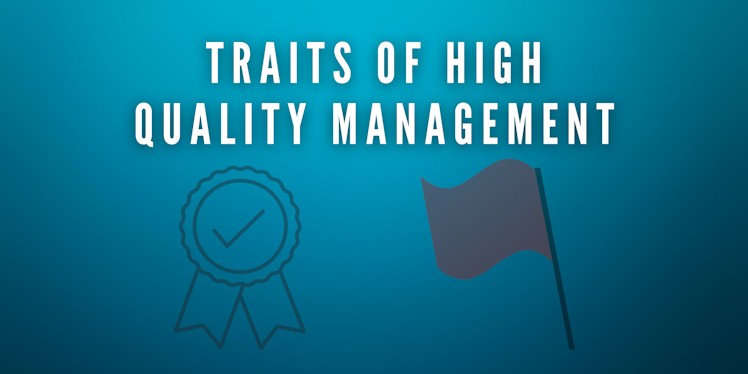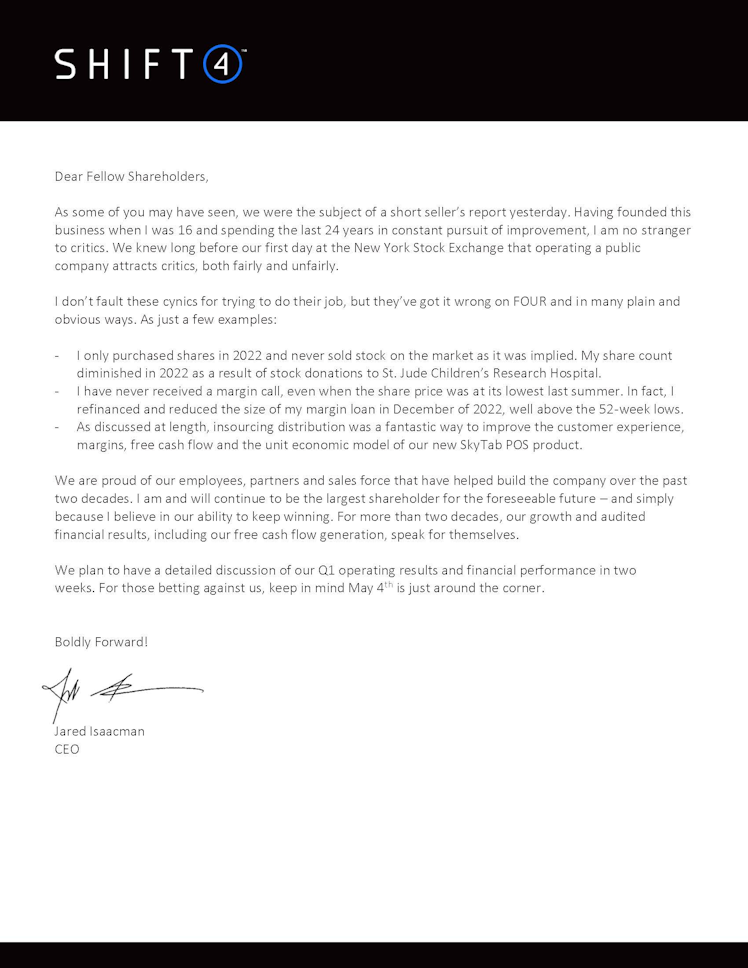Trending Assets
Top investors this month
Trending Assets
Top investors this month
Traits of High Quality Management - 9 Characteristics and 10 Red Flags to Watch Out For
Effective management is crucial for the success of any company. A high-quality management team possesses unique traits that enable them to guide the company toward its goals and create a positive work environment. In this blog post, we will delve into key traits that define a high-quality management team.

Clear Communication
Effective communication is the cornerstone of any thriving workplace, and a top-notch management team recognizes the significance of transparent and clear communication with investors. They ensure that communication channels remain open, honest, and transparent at all times, conveying the company's vision,
mission, and objectives both internally and externally. Clear communication is key to preventing misunderstandings, confusion, and errors.
Skin in the Game
A high-quality management team has skin in the game - they are invested in the success of the company, both personally and financially. This means they are willing to take risks, share responsibilities, and be held accountable for their decisions and actions. When management has a personal stake in the company's success, they are more likely to make decisions that benefit the company in the long term, aligning their interests with
those of the company and its shareholders.
Visionary
A high-quality management team is visionary, with a keen understanding of the company's direction and a compelling vision for the future. They possess strategic foresight and are able to see the big picture, identifying opportunities and challenges. They inspire with their vision and provide guidance and direction to propel the company forward, setting the stage for sustainable growth and success.
Adaptability
In today's rapidly changing business landscape, adaptability is critical for a management team. They are agile and able to respond quickly and effectively to new opportunities, challenges, and market dynamics. They are open to new ideas and perspectives and are willing to pivot and adjust strategies as needed. Their ability to adapt enables the company to stay ahead of the curve and maintain its competitive edge.
Accountability
A high-quality management team embraces accountability. They take ownership of their decisions and actions and are willing to be transparent about their performance. They hold themselves accountable for meeting goals and objectives. They proactively address challenges and take corrective actions, setting a culture of responsibility and integrity throughout the organization.
Strategic Thinking
They think critically and analyze data to identify opportunities, challenges, and risks. They develop and implement effective strategies to achieve long-term objectives and make informed decisions based on thorough analysis and evaluation. Their strategic thinking ensures that the company is well-positioned for success in a dynamic business environment.
Innovation
Innovation is a key driver of growth and competitiveness, and a high-quality management team fosters a culture of innovation. They encourage employees to generate new ideas and provide the necessary resources and support to turn those ideas into reality. They promote creativity, experimentation, and continuous improvement, driving innovation across all aspects of the company's operations.
Capital allocation
Proficiency in capital allocation is often the distinguishing factor between a successful or an unsuccessful investment return. To become a shrewd capital allocator, one must combine the numerous traits mentioned above and condense them into generating the best possible returns for the company. It is crucial to scrutinize the company's history of acquisitions, its return on invested capital (ROIC), and its prospects for venturing into new domains like untapped geographical markets or verticals. I have written a longer article about it here: Capital allocation: The driving force behind business growth
Focus on Shareholder Value
A high-quality management team understands that creating value for shareholders is a primary objective of the company. They prioritize shareholder value by making decisions and taking actions that align with the company's and its investors' long-term interests. They focus on sustainable growth, profitability, and maximizing shareholder returns while maintaining transparency and accountability to shareholders.
Red flags of a low-quality management
It is very easy to reverse the traits, or lack of them would be a sign of low-quality management, so let’s go through a few more concrete signs instead. A number of them are taken from situations I have experienced
myself. Many of these have I got from followers on twitter, thanks for you comments!
Low ownership to salary
When a management team's salary significantly exceeds the amount of capital they've invested, their focus may shift towards protecting their salary rather than enhancing the company's value. This misalignment with shareholders can lead to negative consequences.
A incentive programme that doesn’t increase shareholder value
An effective incentive program is crucial for aligning the interests of shareholders and management to ensure that both parties benefit from the company's success. However, a program based solely on revenue can have
negative effects, as demonstrated by Mercell. By using revenue growth as the primary Key Performance Indicator (KPI) for bonuses, Mercell incentivized acquisitions that increased revenue but did not lead to
increased profits, resulting in a dilution of the share count and a decrease in shareholder value.
Goes after short-sellers and reporters
When short-sellers or reporters speak negatively about a company or accuse it of fraud, management may respond by attacking them publicly. This can involve bad-mouthing them in interviews, taunting them on conference calls, or even accusing them of criminal behavior. Unfortunately, this can create a hostile and dangerous environment, as seen in the Wirecard scandal where a Financial Times reporter was stalked and threatened due to their coverage. However, there are some commendable examples of appropriate responses, such as Lars Wingefors, CEO of Embracer, who simply stated "Everything is as normal here in Värmland," and the CEO of Shift4, who wrote an open letter that was calm, collected, and to the point.

Changes management often
If a company's management team undergoes multiple changes within a relatively short period, it may indicate that there are underlying issues or a shift in organizational culture. A high rate of CFO turnover is particularly concerning. However, if the company has new owners or has recently changed CEOs, a change in management may be precisely what is necessary to drive improvements and bring about positive change.
Too active on social media
Social media can be an incredibly effective tool for companies to communicate with both investors and customers. While some may hold more traditional views and believe that official company communications should be limited to the website and press release systems, I believe that modern investor communication should also involve social media as one of its channels. However, it's important to strike a balance and not go
overboard, to the point where it seems like the company is doing nothing except being on social media. This is especially true when the company is overly active and feels the need to jump into conversations to defend itself.
Over-active communication
While communication is undoubtedly important, it's equally essential to focus on communicating what is relevant and not feel compelled to communicate everything. It's not necessary to make a press release about every little thing, such as the hiring of a new key account manager, which is rather trivial. Doing so merely to increase the number of press releases and demonstrate activity is not beneficial. Communication should be concrete, concise, and clear, ensuring that the message is effectively conveyed.
Focuses too much on forecasting the future/guidance to pull attention away from current business.
If a company is shifting its focus from actual performance to forecasts or guidance, it may be a red flag indicating an attempt to avoid accountability or that the business is not performing as well as previously believed.
It uses buzzwords too much
Using buzzwords like AI, algorithms, metaverse, automation, and digitalization repeatedly while presenting and communicating about a company is a significant red flag. While it's essential for a company to reiterate its goals and vision in a report, using these buzzwords excessively and inappropriately is absurd. It's akin to companies
changing their names to XXX.com during the dot-com bubble or more recently, changing to blockchain or similar, all in an attempt to jump on a trend and deceive investors who aren't conducting adequate research.
Doesn’t follow up statements/claims/goals made in the past
It's crucial to track a company's past statements, claims, and goals, and a failure to do so is a red flag. For instance, if a company presents a particular key performance indicator (KPI) but suddenly stops doing so,
it's important to be cautious and consider what this change may signify for the company.
Pushing everywhere non-GAAP numbers to
show how great the company is doing, while GAAP numbers are not so
great. Pushing an alternative measure of company performance. *
Pushing adjusted of non-GAAP numbers instead of IFRS or GAAP numbers is a clear sign of something is worth to investigate. Especially look at what they adjust compared to the standardized financial reporting systems (IFRS and GAAP).
Too summarise a high-quality management have these qualities:
- Clear Communication
- Skin in the Game
- Visionary
- Adaptability
- Accountability
- Strategic Thinking
- Innovation
- Capital allocation
- Focus on Shareholder Value
In conclusion, a high-quality management team possesses unique traits,including clear communication, skin in the game, visionary leadership,adaptability, accountability, strategic thinking, innovation, and a focus on shareholder value. And a management which show the opposite traits is red-flags and should be looked into thoroughly.
Do you have any favorite CEO or management team? Tell me!
I particularly like Constellation Software’s incentive program and the CEO SaveLend Group Ludwig Pettersson which really shown how strong he is during his battle with testicle cancer. At only 30 years old, crazy!
I write articles like this every week in the hopes of becoming a little better as an investor and you are gladly invited to tag along with me!
Subscribe at https://investacus.substack.com/
Thanks for reading and happy hunting!
investacus.substack.com
Investacus | Douglas Forsling | Substack
Detta nyhetsbrev ger dig uppdateringar om techbolag, analyser och artiklar för att du ska bli en bättre investerare! Click to read Investacus, by Douglas Forsling, a Substack publication with hundreds of subscribers.
Already have an account?